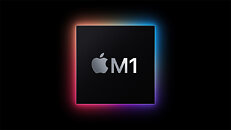Friday, January 15th 2021

Pat Gelsinger: "Intel Has to be Better at Making CPUs Than That Lifestyle Company"
Intel's future CEO Pat Gelsinger, who supersedes current CEO Bob Swan come February 15th, has reportedly compared Intel with Apple's efforts, in wake of that company's decision to leave the Intel ecosystem in favor of in-house designed ARM CPUs. As Apple M1-powered devices hit reviewers' tables, the opinions mostly went one-sided in favor of Apple's decision, clamoring for that particular CPU design to be only lightly short of a computing miracle, considering the amount of computing power provided at that chip's TDP, and running circles around Apple's previous Intel implementations.
According to The Oregonian, a local newspaper from (you guessed it) Oregon where Intel has a strong branch presence, Intel held an all-hands meeting of its Oregon workforce, attended by future Intel CEO Pat Gelsinger, who is quoted as having remarked that "We [Intel] have to deliver better products to the PC ecosystem than any possible thing that a lifestyle company in Cupertino makes. We have to be that good, in the future." Considering how Apple's M1 has raised the world's attention to the ARM architecture as a competitor with strong enough arguments to face the x86 ecosystem (as if ARM powering the world's current fastest supercomputer wasn't a strong enough argument), that seems like a strong yet adequate statement. We'll see how Intel fares with its Alder lake CPUs, which essentially bring ARM's design philosophy of an heterogeneous CPU with both high-performance and high-efficiency cores to the x86 table.
Source:
The Verge
According to The Oregonian, a local newspaper from (you guessed it) Oregon where Intel has a strong branch presence, Intel held an all-hands meeting of its Oregon workforce, attended by future Intel CEO Pat Gelsinger, who is quoted as having remarked that "We [Intel] have to deliver better products to the PC ecosystem than any possible thing that a lifestyle company in Cupertino makes. We have to be that good, in the future." Considering how Apple's M1 has raised the world's attention to the ARM architecture as a competitor with strong enough arguments to face the x86 ecosystem (as if ARM powering the world's current fastest supercomputer wasn't a strong enough argument), that seems like a strong yet adequate statement. We'll see how Intel fares with its Alder lake CPUs, which essentially bring ARM's design philosophy of an heterogeneous CPU with both high-performance and high-efficiency cores to the x86 table.




73 Comments on Pat Gelsinger: "Intel Has to be Better at Making CPUs Than That Lifestyle Company"
Apple was using 10 nm chips back in 2017, and is currently at 5 nm. 3 nm within the next year or so. Intel is still struggling with 10nm capacity.
That M1 is something, it packs a lot of power for SoC and only 10W.
Not to mention it wasn't made by Intel, AMD, Nvidia or IBM, it was Apple their first go at laptop SoC.
Personally initially when I heard I thought it was a joke but reading few reviews and tests especially emulating x86 OSX software it's pretty impressive I'll admit.
If only Microsoft jumps on board and provides proper support for it, it has a lot of potential.
On Intel their IPC is solid but they need newer node and adopting the chiplet design if they want to compete with AMD.
Basically between AMD, APPLE, and NVIDIA, two of which already make better CPUs and one of which is thinking about it, Intel needs a magic trick to get out of the pickle they're in.
'Superglue'
What impressed me is running emulated Windows X86 Witcher on that thing.
Just to put that in perspective we are not emulating OSX x86 to OSX ARM but straight from Windows x86 and it runs, not perfect but runs.
Witcher 3 is demanding game running natively let alone emulated.
We talking about RISC chips so of course we cutting corners here but the bottom line is I don't care if it's smoke and mirrors as long it performs.
Their MAC OSX x86 apps are usable on M1 unlike Windows for Arm where you can't even use Chrome X86 emulated on ARM running super crappy.
There is a lot of fat on X86 and AMD is already making efforts to trim it by cutting bunch of legacy instructions replacing with FPGA section to reduce transistor count and lower power consumption.
With respect to x86, it is high noon for slashing legacy modes and legacy features, and revisiting some over-complicated features. I am not a fan of ARM's business model, but x86 better do something.
Not all Apple users storm out and buy the newest thing. Many ride their hardware for 5+ years before replacement. The M1 Macs were just a significant enough generation to spark more interest. When I've looked, they're always on backorder. I can't tell how much of that is demand and how much of that is COVID.
In regard to Intel, I'd think their bigger embarrassment would be getting caught by tiny ol' AMD, not giant-ass Apple. We all knew this day for Apple was coming, and did people really think that Apple would allow its first home-brew silicon be anything but a solid performer? They've been making SOCs for many years, and they had the luxury of waiting until they knew they could offer something compelling for the Mac line, especially because they are having to convince users to change architectures. A poor showing would be a pretty big setback, though now they are basically past the point of no return, so it's up to them to keep executing.
For a decade they stopped making CPUs without iGPU which was a very suspect move to me. It does not make any sens commercially unless it was dedicated to spy on users (that's the only reason I could find). And they only proposed some high end select few CPUs without iGPU on their last gen (10xxx).
I would not be surprised to see them having the lead for another 10 years.
Saturating the market and relying on mindshare is no longer good enough, Intel need to pull their finger out and make a product worth noticing.
And if you want a "clean slate", I figure it will be nearly impossible to come up with another in-house instruction set when AArch64 and RISC-V are already around.
I'm glad I'm not tasked with solving this problem, but if this guy can, hats off.